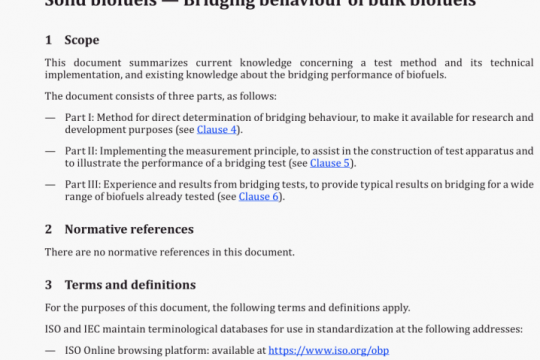EN ISO 19679 pdf free download
EN ISO 19679-2020 pdf free download.Plastics – Determination of aerobic biodegradation of non-floating plastic materials in a seawater/sediment interface – Method by analysis of evolved carbon dioxide [ISO 19679:2020].
Calculate the TOC from the chemical formula or determine it by a suitable analytical technique (e.g. elemental analysis or measurement in accordance with Iso 8245) and calculate the ThCO2.
The form and shape of the test material may influence its biodegradation. Similar shapes and thicknesses should preferably be used if different kinds of plastic materials are to be compared.
NOTE When the test material In form of film is laid down on the surface of the sediment, it can limit the gas exchange between the water body and the sediment, promoting the formation of anaerobic zones under the test material, in order to reduce this effect, it is possible to perforate the film sample homogeneously over the entire surface.
8.2 Reference material
Use ashless cellulose filters as a reference material’). If possible, the TOC, form, and size should be comparable to that of the test material. As a negative control, a non-biodegradable polymer (such as polyethylene) in the same form as the test material shall be used.
8.3 Preparation of the sediment
Filter the sediment in a funnel with a coarse filter paper to eliminate excess seawater. Sediment is ready for testing when dripping of sea water is ended. Sediment after filtering is named “wet sediment hereafter.
8.4 Test setup
Provide several flasks, so that the test includes at least the following:
a) three flasks for the test material (symbol Fr);
b) three flasks for the blank (symbol FH);
c) three flasks for reference material (symbol Fc);
d) three flasks for negative control (symbol FN).
Two flasks for test material, blank, reference material, and negative control may be used instead of three for screening purposes.
8.5 Pre-conditioning phase
In a typical case, use a test flask with a volume of 250 ml. Put 30 g of the wet sediment on the bottom of the flask. Carefully pour 70 ml of natural or artificial seawater. Reactors with higher volumes can be used, if test conditions are not affected. The test should be performed with a water/sediment volume ratio between 3:1 and 5:1 and a sediment layer of about 0,3 cm to 0,5 cm, depending on the granulometry of the sediment.
When using very coarse-grained sediment, the layer can be increased up to 1.5 cm.
Add CO2 absorber to the absorber compartments of the test flask in a typical case 3 ml of KOH 0,5 mol/l or 10 ml of Ba(Ol-i)2 0,0125 mol/l. Place the flasks in a constant-temperature environment and allow all vessels to reach the desired temperature. Take the necessary readings and monitor the CO2 evolution.
This phase is carried out in order to verify that the endogenous respiration is similar in the different vessels and also to obtain a preliminary oxidation of excess organic matter, in order to start the test
1) Laboratory filter paper Whatman n° 42 has been found satisfactory for this purpose and is an example of a suitable product available commercially. This information is given for the convenience of users of this document and does not constitute an endorsement by ISO of this product.
with a lower endogenous respiration. The inoculum can be gently stirred in order to accelerate the biodegradation of excess organic matter.
This phase is generally protracted for a week but is possible to extend this time if a high amount of CO2 evolved is measured.
In case the CO2 evolution of a vessel Is different, reject the diverging vessel or in case of multiple anomalies, start again using new sediment.
8.6 Startofthetest
Dunk the plastic film sample, cut as described in &L on the sediment of each vessel. Mass of samples (test and reference material) should be about 20 mg each when using a flask with a volume of 250 ml corresponding to an initial test item concentration specified in 8d. In order to ensure a homogeneous contact between sample and sediment, it is recommended to cover the sample with a suitable cover slip. The cover slips shall also be introduced in blank vessels, for assuring similar conditions.
NOTE A suitable cover slip can be made using a common non-biodegradable vinyl-coated fibreglass mosquito net with a fibre diameter of about 280 p.tm and a 1,8 mm x 1,6 mm mesh.
For an example, see Annex A.EN ISO 19679 pdf download.




